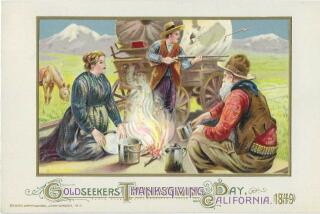A Case of Hit and Myth
- Share via
Every culture needs stories. Here’s one we tell: In 1620, a persecuted group of Christians known as the Pilgrims fled England in search of religious freedom. After a brief sojourn in the Netherlands, they sailed to North America. They landed at Plymouth Rock and worked hard to make a new life.
Their first winter in America proved deadly. Some colonists perished, but, fortunately, generous Native Americans brought the Pilgrims food and taught them to adapt to the new land. As a consequence, most of the colonists survived.
The next year, when they finally celebrated their first harvest, the Pilgrims held a feast and invited their Indian friends. The grateful colonists gave thanks to God for their bounty -- and voila! -- the first Thanksgiving.
We all know that this narrative strays a bit from the truth. The Pilgrims were not warm and loving freedom seekers. They were intolerant people. They could not abide religious pluralism -- that’s one of the reasons they left England -- and once they arrived in New World they were eager to rid themselves of the very neighbors who helped them.
Yet although a few Americans now insist on celebrating Indigenous People Day instead of Thanksgiving, the historical truth seldom interferes with our modern holiday. Nor should it. The truth is beside the point.
We don’t celebrate the Pilgrims; we celebrate the story. The story of the first Thanksgiving is our country’s creation myth. We tell this story now to explain how we became the people who value what we supposedly value: freedom, community, generosity and, in the 21st century version of the tale, ethnic diversity.
The value of the traditional Thanksgiving myth becomes particularly apparent when we try to come up with an alternative, more historically accurate creation story.
Imagine, for instance, if we tried to use the story of Jamestown. Not the Jamestown of Pocahontas and John Smith (that’s another myth, for another essay), but the Jamestown of the starving time. Jamestown was founded in 1607 and, much like the Pilgrims, the first colonists struggled to adapt to their new environment.
Unlike the Pilgrims, however, the Jamestown colonists came to these shores not for religious reasons but financial ones. They came to make their fortunes, and they hoped that England’s America would be like Spain’s America. They wanted a lot of gold and silver and a lot of easily exploitable labor. They found none.
What they found instead were suspicious Native Americans who held the upper hand in regard to food, resources, manpower and self-defense. By the winter of 1609-1610, the colonists, who had always survived by the skin of their teeth, faced dire circumstances. The weather had turned bitterly cold.
Relations with the Indians had become so acrimonious that Native American warriors hid outside Jamestown’s fort and shot well-aimed arrows at any colonist who ventured beyond its palisades. The settlers were trapped.
They had no food. And they were dying: 440 of the 500 colonists died that winter. Some historians suggest that during these bleak and unforgiving days, men held off starvation by eating the flesh of their dead compatriots.
Months later, a ship from England arrived with supplies and new recruits. What remained of Jamestown was saved. The survivors had reason to feel grateful, and, like the Pilgrims, they thanked God.
But who wants to commemorate that story? Who wants to be reminded of the darker symbols woven into our national consciousness? Who wants to reenact the dreams of greed and exploitation that ensnared and undid the victims of Jamestown? No one.
Ironically, the people who lived that story would have had a bitter appreciation of its tragic elements. Seventeenth century Englishmen and -women loved tales of moral complexity -- stories where doomed heroes courageously triumphed over adversity only to self-destruct through hubris and human weakness.
We don’t like those stories (not unless they involve celebrities and politicians we happen to despise, like Rush Limbaugh, William Bennett and Bill Clinton). The stories we want, the ones we pay money for and watch over and over on DVD, have happy endings. We like nice Pilgrims and nice Indians. We like to think that we stand for freedom, community, generosity and diversity.
But no matter how hard we try, we never seem to escape the darker themes of Jamestown: greed, exploitation, suffering. Watch the evening news. You’ll see modern versions of that tragedy every day.
That’s why we need the Thanksgiving story. It helps us forget about Jamestown. In Yann Martel’s novel “The Life of Pi,” a young man spins a breathtaking tale of survival that is wholly surreal and absolutely unbelievable. When questioned by two skeptical insurance investigators, the young man offers another tale that is gruesome, horrific and terrifyingly believable.
“But which is the better story?” he asks his inquisitors. Which would you rather believe?
And so it is with Thanksgiving. Which is the better story? Which is the one worth commemorating: the truth we can believe or the truth we aspire to?


